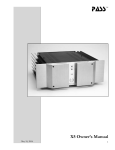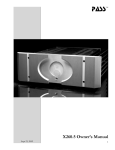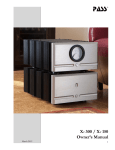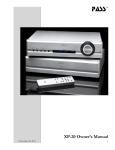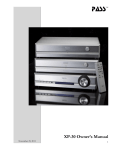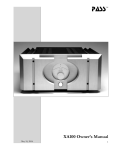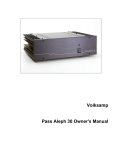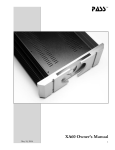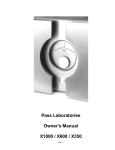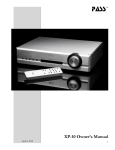Download Pass Labs X2.2 User's Manual
Transcript
pass TM X2.2 Owner’s Manual Aug 10, 2006 X2.2 Owner’s Manual 1 Introduction The X2.2 is an ultra high quality non-remote linestage audio preamplifier with internal power supply. It combines a completely new circuit topology with traditional construction representing thirty five years of preamplifier design. This preamplifier flows from a commitment to create the best sounding product: a simple circuit with the most natural sonic characteristics. Derived from US Patent # 5,376,899, the X2.2 integrates power MOSFET and JFET devices in a simple Class A topology in order to deliver the finest sound possible. The Super-Symmetric gain circuitry is unique in providing superior flexibility and performance with both balanced and unbalanced inputs and outputs, converting one to the other as desired without extra circuitry and without performance degradation. The X2.2 minimizes the number of components in the signal path, and yet retains exemplary objective performance specifications. It pushes the edge of the art in exploring how much subjective quality is obtainable with a new but very elementary gain stage. The X2.2 employs a patented new type of volume control that offers significantly better performance than seen before in an electronic control. It provides over 60 dB of range, large voltage swing and very good measured performance. The distortion and noise is at 1/10 and the dynamic range 100 times the previous state of the art in active attenuation. Most importantly it is subjectively outstanding; better than any potentiometer we have evaluated. The X2.2 may be factory upgraded to the X2.5 which will convey several operational functions and remote control which are absent from the X2.2. The upgrade will also change the front panel display to the more informative vacuum fluorescent alpha-numeric display. Very few people are involved in the production of this product. I supervise all phases of the construction, and I test each preamplifier myself. If you have questions, comments, or problems, please feel free to contact me directly. Thank you for purchasing this preamplifier. It is my sincere hope that you will enjoy its sound as much as I do. Wayne Colburn Vice President, Design X2.2 Owner’s Manual 2 Setup The preamplifier has four sets of input connections, both singleended and balanced output connections, and a separate tape loop. The preamplifier’s voltage and current rating are indicated by affixed tag on the bottom of the preamplifier. It will indicate either 240 volts, 220 volts, 120 volts, or 100 volts. A 0.5 amp 3AG slow blow fuse is provided with 100-120 volt units, and a 0.25 amp slow blow fuse is provided with 220-240 volt units. The frequency rating of the power supply is 50 to 60 Hz in all cases. The preamplifier typically draws less than 30 watts during operation. Please verify that the indicated voltage requirement of this preamplifier is consistent with the voltage at your location. We have provided a standard IEC AC power cord that fits into the IEC line receptacle at the rear of the preamplifier chassis. The preamplifier is equipped for operation with an earth ground provided by the user’s AC outlet. Do not defeat this ground. The circuit ground of the preamplifier is connected to earth and power ground through a power thermistor, which gives a ground connection for safety but helps avoid ground loops. There are a total of four inputs and a separate tape loop. Two of the four inputs can be used single-ended or balanced. The other two inputs are single-ended only. The tape loop has both single-ended and balanced inputs and outputs. Balanced inputs and outputs are via XLR connectors. Single-ended inputs and outputs are via RCA connectors. On the XLR connectors, pin 1 is grounded, pin 2 is the positive signal, and pin 3 is the negative signal. Left channel RCA connectors are marked with “L” from below. Right channel RCA connectors are marked with “R” from below. Balanced XLR inputs and outputs are marked with “L” for left and “R” for right channel. If your signal source is unbalanced, input will occur through the RCA input connector, which is in parallel with the XLR connections 1 and 2. When single-ended inputs are used on input 1 and input 2, a shorting plug is provided between pins 1 and 3 of the XLR connection, shorting the negative input to ground, and providing optimal performance. The unbalanced input impedance of the preamplifier is 33 kOhms. In balanced mode, the input impedance is higher, with a differential impedance of at least 66k Ohms. Next to the inputs on the rear panel, the preamplifier offers tape inputs through both XLR and RCA connectors. This output is a direct connection to inputs 1, 2, 3, and 4 when they are selected from X2.2 Owner’s Manual 3 the front panel. Input 5 (TAPE IN) is deliberately not available through the tape output connection. The tape input is designated for use with a tape recorder if you have one, and we have arranged that it will not place its output on the tape out, which will prevent you from accidentally creating a feedback connection with your tape machine. The main outputs are located at the left-hand side (viewed from the rear) of the rear panel, two male XLR connectors, and two RCA connectors, “R” (right) and “L” (left). The RCA connectors’ ground is in parallel with pin 1 of the XLR outputs and the RCA hot is fed from an independent summing junction that maximizes the X circuit benefits. The RCA, single-ended outputs are buffered from the balanced outputs. You may use both the single ended and balanced outputs at the same time. On the XLR, pin 1 is ground, pin 2 is positive, and pin 3 is negative. The rear 5-way binding post can be used to turn on any X series power amplifier. Description of Operation In application the X2.2’s front panel controls and simple LED displays are quite straight forward, and intuitive. We encourage you to become familiar with their operation prior to establishing any input connections with this unit. Experience indicates that engaging in a few minutes of exploration and playtime will add much to your ultimate enjoyment of this exceptional Pass Labs product. The front panel of the X2.2 has all its control functions moderated by five momentary pushbuttons. From left to right these buttons are labeled input, tape, volume (down), volume (up) and mute. The input button has four associated blue LED’s located directly above the input switch. When the uppermost blue LED is lit it indicates that you have selected input number 1. With an additional push of the input selector button the second uppermost LED will be on, indicating you have selected input number 2. So it goes, the same pattern follows with input 3 and 4. An additional push of the input selection button when you are on input 4 will cycle the preamplifier back to input 1. The second button from the left controls the tape loop, a blue LED directly above this switch indicating the status of this particular function. When the tape loop is active, this LED will be lit. Immediately to the right of the tape loop control are the two volume X2.2 Owner’s Manual 4 control buttons, indicated by up arrows (^) and down (v) arrows. Above the volume controls are two vertical arrays of 4 LEDs each. This indicator is likely different from what you are accustomed to. We think you will appreciate how easy it is to read from a distance. The left most LED array is decade and the right most array is range. Associated with the volume control is one additional light and a function control button labeled as “MUTE”. In the very lowest volume setting there will be no output and the “Mute” indicator light will be lit. Immediately to the left of the lit “MUTE” indicator the lowermost LED in the range column will also be lit. None of the decade LED’s will be lit, at this time. As you step the volume upward using the up (^) button additional LED’s in the range column will light and the mute LED will extinguish. When you reach the top of the range, the first decade LED will become illuminated, and the range LED will drop back to its lowest indicated setting. And so it goes; think of this as a counting system in base 5. Activating “MUTE” while at any volume level does not lose the chosen volume setting. When deactivating mute the X2.2 will be returned to the last stored volume level. Should you wish to upgrade the 2.2’s status to a full function remote control preamplifier, this may be acomplished at the factory. With additional circuitry and new front panel the X2.2 may be turned into an X2.5 This upgrade adds an informative vacuum fluorescent display, balance control, display brightness, mono, unity function, gain setting and remote control capability. A rear mounted pair of five-way binding posts are intended to control the on/off function of our own X series power amplifiers from the X2.2 front panel. This function is activated through software by simultaneously pushing the extreme left control button (INPUT) and the extreme right (MUTE) control button. When the preamp mode “Amp” is selected it allows the user to switch a nominal 12 volts DC at maximum draw of 50 milliamps to the rear panel red and black five-way binding posts. In some instances this voltage may have the ability to control products from other manufacturers, but we by no means have comprehensive listing of their compatible features. If you have questions about compatibility your service technician and dealer are an excellent source of information. For connection to other Pass Labs products please consult the owner’s manual for specific instructions. The electronic volume control allows approximately 60 dB range. In this manner tracking of the volume of the two balanced channels is possible with accuracy unavailable on any ordinary volume control, X2.2 Owner’s Manual 5 assuring precise level steps and high common-mode rejection in balanced circuits. Wayne Colburn’s exceptional volume control, in conjunction with the unique LED display, gives the user the ability to replicate volume levels with absolute accuracy in steps of roughly 3dB. Product Philosophy 1) Circuit simplicity and a minimum number of components is a key element. The fewer parts in series with the signal path, the better. Adding more parts and gain stages may improve measured specs, but will seldom improve the perceived sonic quality or reliability of a product. 2) The characteristic of gain devices and their specific use is important. Individual variations in performance between like devices are important, as are differences in topological usage. All signal bearing devices contribute to the degradation, but there are some different characteristics that are worthy of attention. For example, smooth low order nonlinearities are additive in quality, bringing false warmth and coloration, while abrupt high order nonlinearities add harshness and false brightness. 3) Maximum intrinsic linearity is desired. This is the performance of the gain stages before feedback is applied. Experience suggests that feedback is a subtractive process; it removes information from the signal. In many older designs, poor intrinsic linearity has been corrected by large application of feedback, resulting in loss of warmth, space, and detail. The trick is to get good performance without this excessive reliance on feedback. The art of high end audio design lies in the approach of combining these elements to get high reliability and simplicity, high quality measured performance, and high quality subjective performance. It takes imagination and hard work to get as much of these as possible at once without trading them off against each other. Other Design Comments We recommend the use of the balanced output mode where possible. It will retain the character of the input mode, but offers less distortion, less noise, more gain, and more voltage swing, without compromising the sound. With balanced operation, the common-mode rejection of the preamp reflects the intrinsic common-mode rejection of the topology, the matching of the gain devices, and the matching of the attenuator channels. In this case we have been able to keep X2.2 Owner’s Manual 6 the total mismatch to about .1%, for a common-mode rejection of approximately -60 dB. The input system of the preamplifier will exhibit full common-mode noise rejection with passive balanced sources, where the negative input is connected to ground at the source through the appropriate source impedance. This allows adaptation of unbalanced sources to balanced operation with passive cable connections in a manner that achieves the noise rejection of active balanced sources. The use of a micro-controller allows all of the preamplifier functions to be repeatable and accurately controlled. The micro-processor only controls the functions of the preamplifier. At no time does any of the input or output signal come into contact with the digital control signals. The digital circuits are powered by a power supply that is completely separate from the analog supply. Should it ever be necessary to update the software that controls the functioning of the preamp only the socketed micro-processor need be changed. The power supply for the X2.2 consists of a toroidal power transformer delivering an unregulated +/- 45 volts which is actively regulated before feeding passive filtering and powering the constant current sources which bias the gain stages. Each channel has its own regulation. The power supply noise reaching the circuit is on the order of one microvolt, and the little of that which gets through the circuit is rejected at the output in a balanced system. The relays and control systems are regulated independently, and all digital circuitry is isolated from the power supply. Muting relays, which delay connection during turn-on and shut off the output when insufficient power supply is available to maintain regulation, guard the output of the preamplifier. The preamplifier is designed to run constantly, and will exhibit optimum measured performance within about 10 hours of turn-on. The X2.2 consists of a single chassis. X2.2 Owner’s Manual 7 X2.2 Specifications Gain, Balanced: selectable 4 / 14dB Gain, single-ended: selectable 4 / 14 dB Freq. Response: -3 dB @ 2 Hz, -3 dB at @ 100K Hz Distortion @ 1KHZ: < .1 % THD, typically .003% @ 2 volts Maximum Output: 10 volts rms. bal out, 7 volts rms. unbal Output Impedance: 200 ohms unbal, 750 ohms balanced Input Impedance: 33K Ohm unbal, 66K Ohm balanced CMRR: typ. -55 dB, 1KHz Crosstalk: typ. -85 dB, 1KHz Output Noise floor: < -125 dBV, 20Hz to 20KHz External amp turn on: 12 volts DC 50 mA continuous Power Consumption: 35 watts Dimensions: 17” W x 11.5 “D Shipping Weight: 28 Lbs in packing x 3.5”H Pass Laboratories Inc. P.O. Box 219, 24449 Foresthill Rd., Foresthill, CA 95631 Tel: 530.367.3690, Fax: 530.369.2193, www.passlabs.com © 2006 Pass Laboratories Inc. “Pass”, “pass”, “Pass Labs”, “Pass Laboratories”, Supersymmetery”, “Aleph”, and “Zen” and are all registered trademarks of Pass Laboratories, Inc., and all rights thereto are protected by law. X2.2 Owner’s Manual 8 Warranty Information Please check with the factory-authorized distributor in the country you are purchasing this product for specific warranty information. All Pass Laboratories products purchased from an authorized Pass Laboratories dealer in North America are covered by a transferable, limited 3-year warranty. This warrantee includes all parts and labor charges incurred at the repair facility in addition to return shipping to the domestic customer, exclusive of subsequent damages. Damage due to physical abuse is specifically not covered under this warranty. For this warranty to apply the customer is responsible for returning the product unmodified to the factory within the warranty period. The customer assumes all responsibility for shipping and insurance to the factory or a factory specified repair facility. The conditions and stipulations of this Pass Laboratories warranty only applies to units sold new in North America. Non-North America customers should consult with their original Pass Labs dealer or distributor for warrantee repair instruction prior to contacting the factory or shipping product for repair. Non-North American product must be returned to the country of origin for warrantee service. Foreign distributors are only required to offer warranty service on Pass Laboratories product that they have imported. Please note: Conditions of warranty service and customer rights for product purchased outside the United States may vary depending upon the distributor and local laws. Please check with your local distributor for specific rights and details. Any modifications to Pass Laboratories products that have not received written factory approval nullify all claims and void the warrantee. Should a modified product be returned to the factory for repair the owner will be required to pay all necessary charges for the repair in addition to those charges required to return the product to it’s original configuration. In the case of safety issues, no product shall be returned to the customer without those safety issues being corrected to the most recent accepted standards. Removal or alteration of original Pass Labs serial numbers voids the factory warranty. Product with altered or missing serial numbers will be suspected as counterfeit product. Pass Laboratories will not repair or in any way indemnify any counterfeit or cloned product. Pass Laboratories does not offer products in voltages intended for international markets either to authorized Pass Labs dealers or to third parties located in the United States or Canada. X2.2 Owner’s Manual 9 For your protection please read the following: Water and moisture: Electrical devices should not be used near water ( as per example, near a bathtub, washbasin, kitchen sink, laundry tub, wet basement or swimming pool ). Care should be taken such that objects do not have the opportunity to fall, and that liquid is never spilled onto or into the device enclosure through openings. Power Sources: An electrical device must be connected to a mains power source in strict accordance with the supplied product owner’s manual. Please verify that the AC mains voltage specified in the product manual matches those requirements indicated on the unit and the AC voltage provided to your location by the power company. Grounding: Adequate precautions should be taken so that the grounding provisions built into an electrical product are never defeated. Power Cords: Pass Laboratories provides a power supply cord that meets all legislated requirements for the market in which the product was originally sold. If you choose to substitute an after-market product we urge you to choose one that is fully safety rated by the necessary local authority. Power Cord Protection: Power supply cords should be routed so that they are not likely to be walked on, abraded, or pinched by items placed on or against them, paying particular attention to cords where they enter plugs or exit from a device. Never under any circumstance insert a cut or damaged power cord into a mains power socket. Power and Signal: Cables should never be connected / disconnected with equipment powered up. Failure to heed this warning may damage or destroy equipment. Ventilation: Power-amplifiers run hot, but you should be able to place your hands on them without discomfort. You must allow for this heat in installation, by providing for free air circulation around the product. Electronics should not be subjected to sources of excessive radiant heat. Excessive heat can shorten the life of the product and may cause the electronics to self-protect and shut down. Servicing: To reduce the risk of fire, electrical shock or other injuries, the user should not attempt to service the device beyond that which is described in the operating instructions. All other servicing must be referred to qualified service personnel. X2.2 Owner’s Manual 10










